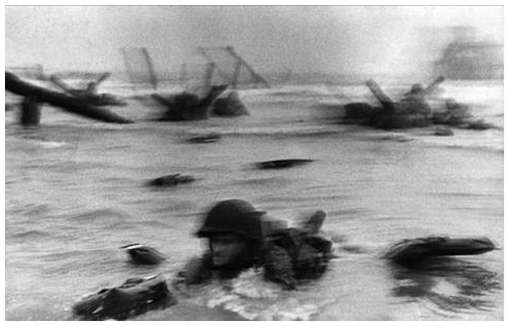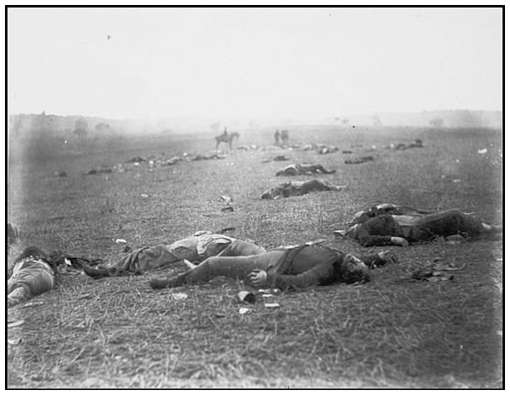Ok i came across this article the other day and immediately thought of my numerous friends who are avid “Shutterbugs”.Take note that these are photographs which had some kind of political,cultural or scientific
impact on the society and therefore you may not find some really popular ones in here.Like the “Afghan Girl” by Steve McCurry
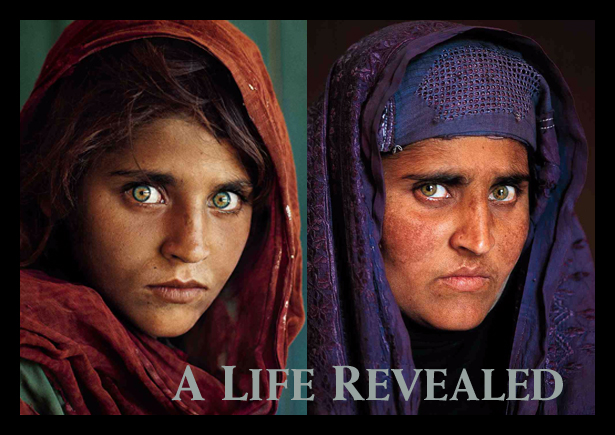
So here is a list of the photography that literally “Changed” humankind
[1]Omaha Beach, Normandy, France” Robert Capa, 1944
“If your pictures aren’t good enough,” war photographer Robert Capa used to say, “you aren’t close enough.” Words to die by, yes, but the man knew of what he spoke. After all, his most memorable shots were taken on the morning of D-Day, June 6, 1944, when he landed alongside the first waves of infantry at Omaha Beach.
Caught under heavy fire, Capa dove for what little cover he could find, then shot all the film in his camera, and got out – just barely. He escaped with his life, but not much else. Of the four rolls of film Capa took of the horrific D-Day battle, all but 11 exposures were ruined by an overeager lab assistant, who melted the film in his rush to develop it. (He was trying to meet the deadline for the next issue of Life magazine.)
In an ironic twist, however, that same mistake gave the few surviving exposures their famously surreal look (”slightly out of focus,” Life incorrectly explained upon printing them). More than 50 years later, director Steven Spielberg would go to great lengths to reproduce the look of that “error” for his harrowing D-Day landing sequence in “Saving Private Ryan,” even stripping the coating from his camera lenses to echo Capa’s notorious shots.
[2]Federal Dead on the Field of Battle of First Day, Gettysburg, Pennsylvania” Mathew Brady, 1863
As one of the world’s first war photographers, Mathew Brady didn’t start
out having as action-packed a career as you might think. A successful daguerreotypist and a distinguished gentleman, Brady was known for his portraits of notable people such as Abraham Lincoln and Robert E. Lee. In other words, he was hardly a photojournalist in the trenches.
In fact, Brady had everything to lose by making a career move – his money, his business, and quite possibly his life. Nevertheless, he decided to risk it all and follow the Union Army into battle with his camera, saying, “A spirit in my feet said, ‘Go!’” And go he did – at least until he got a good look at the pointy end of a Confederate bayonet.
After narrowly escaping capture at the first Battle of Bull Run, Brady’s chatty feet quieted down a bit, and he began sending assistants in his place. In the span of only a few years, Brady and his team shot more than 7,000 photographs – an astounding number when you consider that developing a single plate required a horse-drawn-wagon-full of cumbersome equipment and noxious chemicals. Not exactly what you’d call “point-and-shoot.”
Tethered as he was to his equine-powered darkroom and with film speeds being much slower then, Brady produced war photos that are understandably light on the action and heavy on the aftermath. Still, they mark the first time Americans were so immediately confronted with the grim realities of the battlefield.
[3]Murder of a Vietcong by Saigon Police Chief” Eddie Adams, 1968
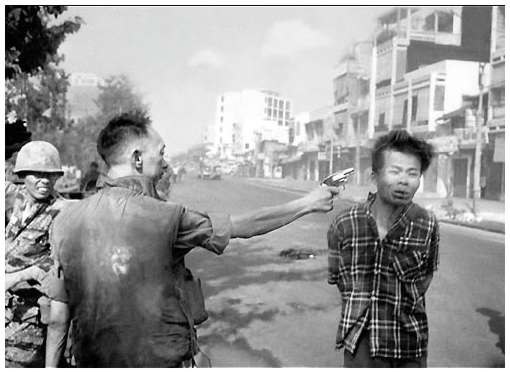 “Still photographs are the most powerful weapon in the world,” AP photojournalist Eddie Adams once wrote. A fitting quote for Adams, because his 1968 photograph of an officer shooting a handcuffed prisoner in the head at point-blank range not only earned him a Pulitzer Prize in 1969, but also went a long way toward souring Americans’ attitudes about the Vietnam War.
“Still photographs are the most powerful weapon in the world,” AP photojournalist Eddie Adams once wrote. A fitting quote for Adams, because his 1968 photograph of an officer shooting a handcuffed prisoner in the head at point-blank range not only earned him a Pulitzer Prize in 1969, but also went a long way toward souring Americans’ attitudes about the Vietnam War.
For all the image’s political impact, though, the situation wasn’t as black-and-white as it’s rendered. What Adams’ photograph doesn’t reveal is that the man being shot was the captain of a Vietcong “revenge squad” that had executed dozens of unarmed civilians earlier the same day. Regardless, it instantly became an icon of the war’s savagery and made the official pulling the trigger – General Nguyen Ngoc Loan – its iconic villain.
Sadly, the photograph’s legacy would haunt Loan for the rest of his life. Following the war, he was reviled where ever he went. After an Australian VA hospital refused to treat him, he was transferred to the United States, where he was met with a massive (though unsuccessful) campaign to deport him. He eventually settled in Virginia and opened a restaurant but was forced to close it down as soon as his past caught up with him. Vandals scrawled “we know who you are” on his walls, and business dried up.
Adams felt so bad for Loan that he apologized for having taken the photo at all, admitting, “The general killed the Vietcong; I killed the general with my camera.”
[4]V-J Day, Times Square, 1945″, a.k.a. “The Kiss”Alfred Eisenstaedt, 1945
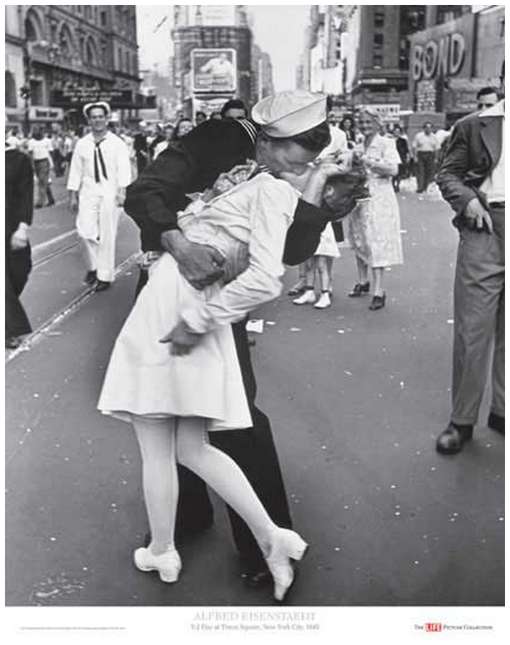 On August 14, 1945, the news of Japan’s surrender was announced in the United States, signaling the end of World War II. Riotous celebrations erupted in the streets, but perhaps none were more relieved than those in uniform. Although many of them had recently returned from victory in
On August 14, 1945, the news of Japan’s surrender was announced in the United States, signaling the end of World War II. Riotous celebrations erupted in the streets, but perhaps none were more relieved than those in uniform. Although many of them had recently returned from victory in
Europe, they faced the prospect of having to ship out yet again, this time to the bloody Pacific.
Among the overjoyed masses gathered in Times Square that day was one of the most talented photojournalists of the 20th century, a German immigrant named Alfred Eisenstaedt. While snapping pictures of the celebration, he spotted a sailor “running along the street grabbing any and every girl in sight.” He later explained that, “whether she was a grandmother, stout, thin, old, didn’t make any difference.”
Of course, a photo of the sailor planting a wet one on a senior citizen wouldn’t have made the cover of Life, but when he locked lips with an attractive nurse, the image was circulated in newspapers across the country. Needless to say, “V-J Day” didn’t capture a highly anticipated embrace by long-lost lovers, but it also wasn’t staged, as many critics have claimed. In any case, the image remains an enduring symbol of America’s exuberance at the end of a long struggle.
[5]The Corpse of Che Guevara” Freddy Alborta, 1967
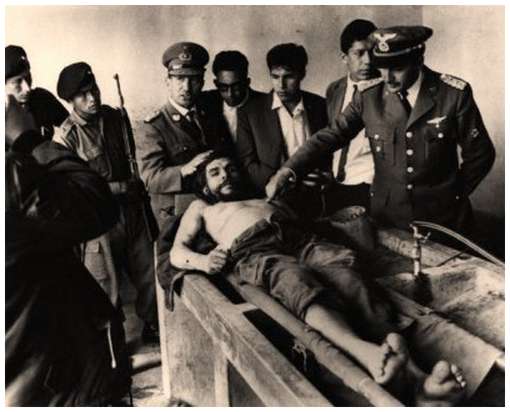 Sociopathic thug? Socialist luminary? Or as existentialist Jean-Paul Sartre called him, “the most complete human being of our age”? Whatever you believe, there’s no denying that Ernesto “Che” Guevara has become the patron saint of revolutionaries. Undeniably, he is a man of mythical status – a reputation that persists less because of how he lived than because of how he died.
Sociopathic thug? Socialist luminary? Or as existentialist Jean-Paul Sartre called him, “the most complete human being of our age”? Whatever you believe, there’s no denying that Ernesto “Che” Guevara has become the patron saint of revolutionaries. Undeniably, he is a man of mythical status – a reputation that persists less because of how he lived than because of how he died.
Unenthused by his efforts to incite revolution among the poor and oppressed in Bolivia, the nation’s army (trained and equipped by the U.S. military and the CIA) captured and executed Guevara in 1967. But before dumping his body in a secret grave, they gathered around for a strategic photo op. They wanted to prove to the world that Che was dead, in hopes that his political movement would die with him. in fact, anticipating charges that the photo had been faked, Che’s thoughtful captors amputated his hands and preserved them in formaldehyde.
But by killing the man, Bolivian officials unwittingly birthed his legend. The photo, which circulated around the world, bore a striking resemblance to Renaissance paintings of Christ taken down from the cross. Even as Che’s killers preened and gloated above him (the officer on the right seems to be inadvertently pointing to a wound on Guevara’s body near where Christ’s final wound was inflicted), Che’s eerily peaceful face was described as showing forgiveness. The photo’s allegorical significance certainly wasn’t lost on the revolutionary protesters of the era. They quickly adopted “Che lives!” as a slogan and rallying cry. Thanks to this photograph, “the passion of the Che” ensured that he would live on forever as a martyr for the socialist cause.
So hope you liked this one.Please do comment on all the articles and may be write(Or copy paste) some of your own.

